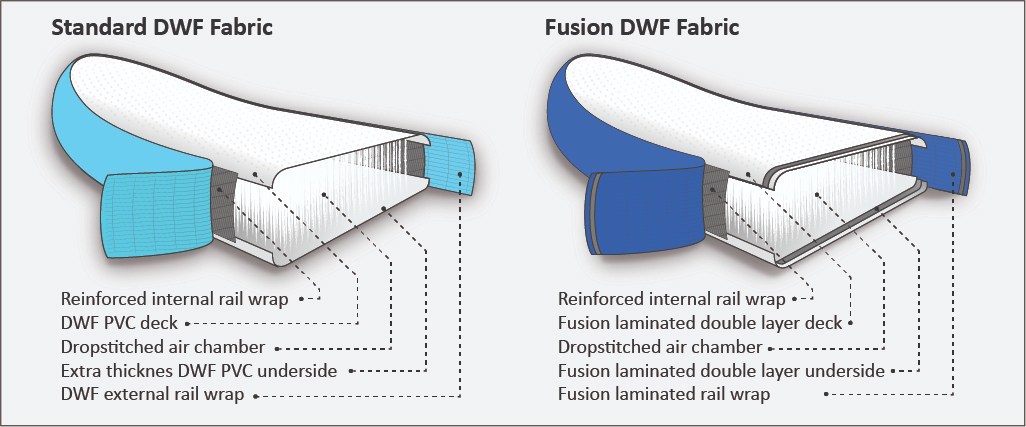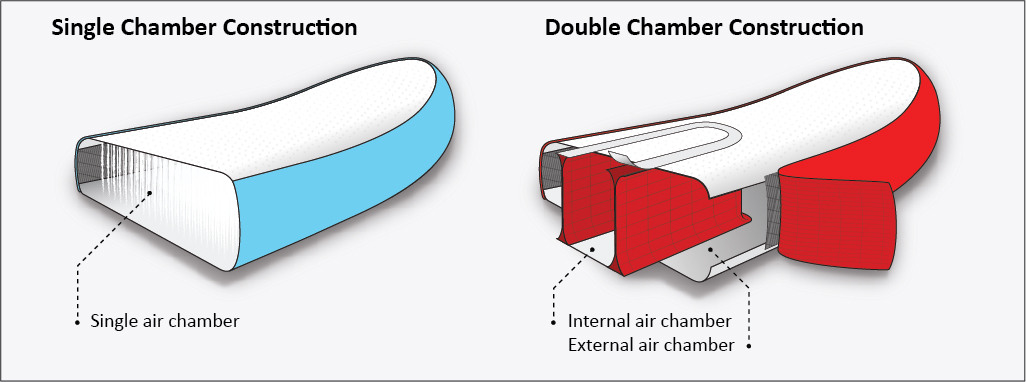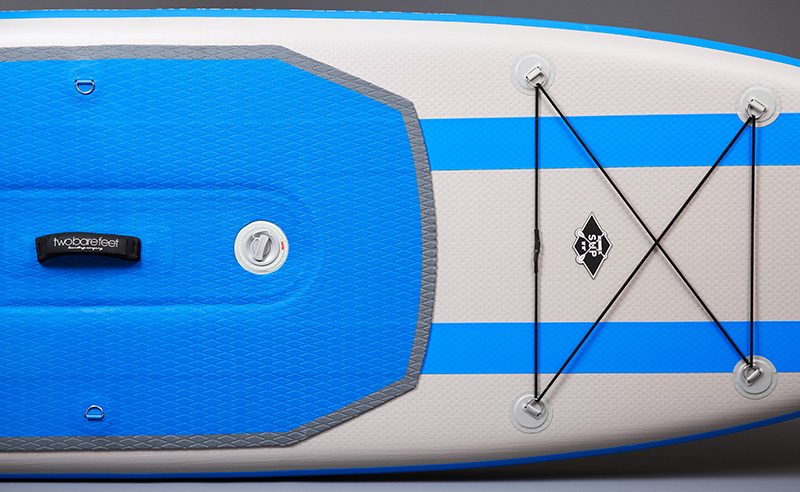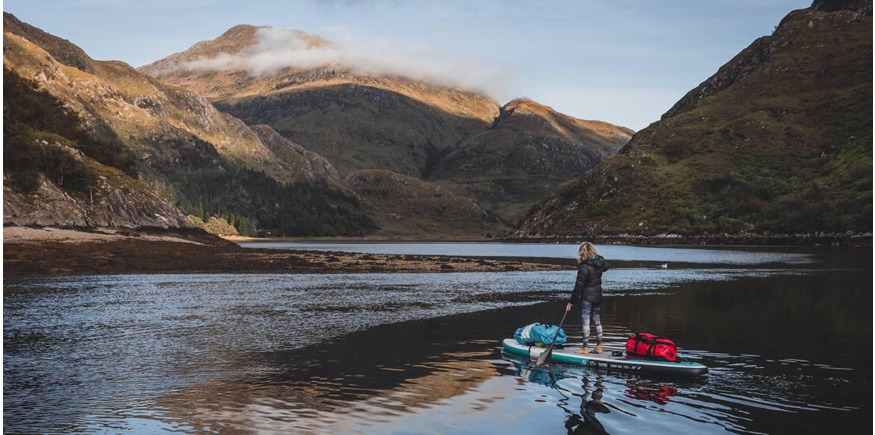With the wealth of options available now, the inflatable SUP market can be a hard space to navigate if you’re looking to purchase your first paddleboard or upgrade from a sub-standard one. Stand up paddleboards fall into a number of different categories for different disciplines and all vary in terms of shape, length, width and thickness, and could have different features on the deck as well as fin set ups. We’ve created this all-inclusive guide to help get you on the right board.
Board Style / Board Categories
All-round SUPs
The first thing to consider when starting your search for an inflatable SUP is what kind of paddling do you want to do. If you’re just starting out, it’s likely you want an all-round board that can do a bit of everything and make your life easy whilst learning. All-round SUPs typically have a quite a round, wide template where the width is carried through the nose and tail to give you a very stable paddleboard. Often these boards come in different thickness options as well, for example: our XL range which can accommodate more weight and the possibility of carrying passengers.

Surf SUPs
If you’re already into paddleboarding but are looking to catch waves on a more capable board, there are many surf specific SUPs available. These are typically shorter (10ft and under) and feature a squarer, narrower tail with a more pointed nose. These characteristics make them more manoeuvrable and agile whilst navigating a line-up and catching and riding waves.

Touring SUPs
Touring SUPs are for paddlers who really want to cover some distance and go on extended trips out on the water. These are longer than the two previous types of board, (around 12 feet) and whilst they can be wide through the mid-section of the board, they will often taper to more of a point in the nose and be narrower at the tail than an all-round board.
The extra length and narrower profile helps with glide, meaning you can cover more distance with each stroke. You’ll also find there’s more space on board to stow extra gear for long trips.

Racing SUPs
Racing SUPs are less common as inflatables but they are available. Inflatable racing SUPs are generally for experienced paddlers who are entering events or are in training.
They can reach up to 14 feet in length and similarly to a touring SUP, except much more extreme, they will taper to a point at the nose. The reason for this is to promote glide but also allow you to reach higher top speeds thanks to superior hydrodynamics. Stability is compromised, meaning they are really just for experienced paddlers, but they will cut through the water with ease.

Paddleboard size
Once you’ve narrowed down the type of board you want, this will affect the size of board you choose, however, there are still different sizes in each category and it’s important to get the one best suited to you. The main thing that will decide on the size of board you pick is your weight. It’s all about getting the right balance of weight of rider and the volume of the board: thicker, longer or wider equals more volume.
If you are too heavy for your board, it will struggle to effectively float you and whilst its incredibly unlikely it will sink, it is likely that the board will sit too low in the water making paddling ineffective. At opposite end of the scale, if you are too light for your board, it will sit too high in the water which compromises stability. You don’t have to be incredibly precise but it is a good idea to pay attention to the recommended weight limits we have included in all of our inflatable paddleboard descriptions.
iSUP Materials and Construction
Single Layer vs Double Layer SUP
The materials your board is made from and the way they are put together will have a huge effect on the board’s performance, durability and overall weight which is worth considering when it comes to transportation.
To start with, inflatable paddleboards are all made using PVC but you will find some are single layer and some are double layer. Both of these construction methods have their advantages: a single layer of PVC is lightweight, making these boards easier to handle on flat water and easier to transport. On the other hand, double layer PVC construction makes for a more rigid and durable board. These characteristics increase performance and resistance to punctures.

At Two Bare Feet, we offer somewhat of a middle ground, with PVC and carbon fibre stiffening strips on the top and bottom of some of our models. These strips increase the rigidity and therefore performance of the board without a significant increase in weight over a standard single layer model. These strips are utilised on our Archer and Sport Air Super Premium ranges.
Single chamber or double chamber inflatable SUP
You should also consider your air chamber setup. The majority of iSUPs are made with a single air chamber, which will perform very well when in tandem with the DWF and Fusion DWF fabrics which are standard on all of our boards. However, a double chamber paddleboard does offer an upgrade.
Double chamber SUPs are constructed with an external and internal air chamber, each with their own DWF laminates and pressure retention valves. Each of these holds up to 18 Psi of pressure like a single chamber model.
However, the two separate chambers work to minimise air displacement in order to reduce bowing in the board, increasing rigidity and stability by up to 30%. The extra materials do a add a little weight but there are also safety benefits. If you were to experience the unlikely event of a puncture, the second chamber is still capable of retaining enough air to keep you paddling and get you safely to shore.

Deck Pad and Accessories
One final thing to consider, which isn’t quite as important but can make a difference in terms of practicality and comfort, is the setup of your deck pad and any on-board accessories.
A nice thick, grippy deck pad goes a long way for comfort, especially if you’re doing long distance paddles, and all of our TBF SUPs feature just that via our signature, heat-moulded diamond pad. Our Inviato model also features a full-length deck pad running nose-to-tail, which will suit you well if you plan on having passengers or four legged friends on board. The pad provides grip all over and protection from sharp claws.

Elsewhere on the deck, you may want to think about D-rings, bungee cords and carry handles: where these are placed and their frequency can make all the difference. Our TBF range of boards may vary in terms of these three components—for example: larger touring and race models are equipped with extra bungees for storage you might need for a long-distance trip, whereas smaller models might not have the space.
All of our paddleboards are equipped with centre mounted carry handles positioned to provide perfect balance and make your life easy, as well as handles at the nose and tail so you can share the lifting.
if you have any further questions what to look for when purchasing a new SUP – be it first time or an upgrade - please don't hesitate to contact us. If not, head to our SUP shop and be sure to read into our paddleboard descriptions where we've provided plenty of information on all of the above considerations.




